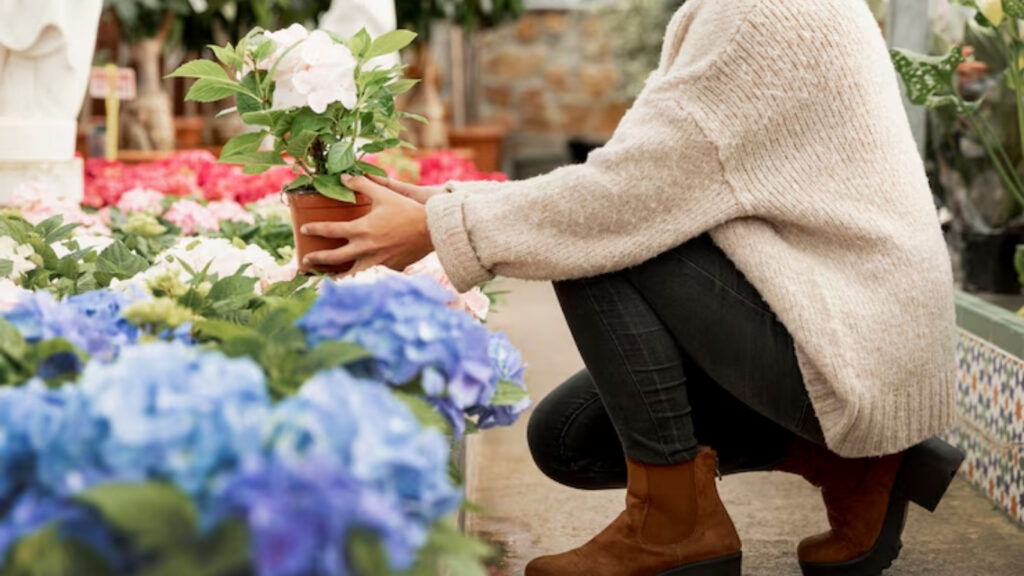Hortensia, more commonly known as hydrangea, is a beloved flowering plant celebrated for its lush blooms, varied colors, and enchanting presence in gardens worldwide. These eye-catching shrubs are a gardener’s delight and can turn any outdoor or indoor space into a floral haven. Whether you’re a seasoned gardener or a novice plant lover, this comprehensive guide will help you understand, grow, and care for Hortensia plants.
Table of Contents
- Introduction to Hortensia
- Botanical Profile and Origin
- Popular Types of Hortensia (Hydrangea Varieties)
- Soil, Water, and Light Requirements
- Seasonal Care and Maintenance
- Pruning Techniques
- Fertilization Tips
- Common Problems and Solutions
- Color Control: Why Hydrangeas Change Colors
- Indoor vs. Outdoor Growing
- Landscape Uses and Garden Design Ideas
- Propagation Methods
- Symbolism and Cultural Significance
- Frequently Asked Questions
- Conclusion
1. Introduction to Hortensia
Hortensia, often synonymous with the term “hydrangea,” refers to a genus of over 70 species of flowering plants. These plants are best known for their ball-shaped flower clusters and ability to adapt to various climates. Originating in Asia and the Americas, the hortensia has grown in popularity due to its striking visual appeal and relative ease of care.
2. Botanical Profile and Origin
- Scientific Name: Hydrangea spp.
- Family: Hydrangeaceae
- Common Name: Hortensia (especially in French-speaking regions)
- Native To: Japan, Korea, China, the Americas
Hydrangeas were first cultivated in Japan and later spread to Europe and North America. The name “Hortensia” was coined in France and became an alternate name for the plant, especially for Hydrangea macrophylla, the bigleaf hydrangea.
3. Popular Types of Hortensia (Hydrangea Varieties)
There are many types of hydrangeas, but here are some of the most beloved:
a. Hydrangea macrophylla (Bigleaf Hydrangea)
- Known for color-changing blooms.
- Varieties include mophead and lacecap types.
b. Hydrangea paniculata (Panicle Hydrangea)
- Cone-shaped flower clusters.
- More sun-tolerant and cold-hardy.
c. Hydrangea arborescens (Smooth Hydrangea)
- Native to the U.S.
- Popular cultivar: ‘Annabelle’.
d. Hydrangea quercifolia (Oakleaf Hydrangea)
- Unique oak-shaped leaves that turn red in fall.
- Excellent for naturalistic gardens.
e. Hydrangea petiolaris (Climbing Hydrangea)
- A climbing vine with lacecap blooms.
- Ideal for walls and trellises.
4. Soil, Water, and Light Requirements Hortensia
Hydrangeas thrive under specific conditions:
Soil:
- Well-drained, rich, loamy soil.
- pH affects flower color (especially in H. macrophylla).
Water:
- Hydrangeas love water; the name derives from “hydra” (water).
- Regular watering is crucial, especially in dry seasons.
Light:
- Morning sun and afternoon shade are ideal.
- H. paniculata tolerates full sun better than other types.
5. Seasonal Care and Maintenance
Spring:
- Apply mulch and fertilizer.
- Prune dead wood.
Summer:
- Water deeply during dry spells.
- Deadhead spent flowers.
Fall:
- Reduce watering as temperatures drop.
- Stop fertilizing to let the plant prepare for dormancy.
Winter:
- Apply mulch around the base for insulation.
- Protect with burlap in very cold regions.
6. Pruning Techniques Hortensia
Pruning is crucial for maintaining healthy and attractive plants. The timing and method vary by species:
- Bigleaf and Oakleaf Hydrangeas: Prune after flowering. They bloom on old wood.
- Panicle and Smooth Hydrangeas: Prune in late winter or early spring. They bloom on new wood.
Always use clean, sharp shears to avoid disease and damage.
7. Fertilization Tips
Fertilizing hydrangeas boosts their blooming potential Hortensia:
- Use a balanced, slow-release fertilizer in spring.
- For blue blooms: use acid-loving plant fertilizer.
- For pink blooms: add garden lime to increase alkalinity.
Avoid over-fertilizing, which can lead to excessive foliage and few flowers.
8. Common Problems and Solutions
Like any plant, hydrangeas can face issues:
Pests:
- Aphids and spider mites can be washed off or treated with neem oil.
- Slugs may need organic slug bait.
Diseases:
- Powdery mildew: Improve air circulation.
- Root rot: Avoid overwatering and ensure good drainage.
Other Issues:
- Wilting in hot sun: Provide shade or water more frequently.
- No blooms: Pruning at the wrong time or too much nitrogen.
9. Color Control: Why Hydrangeas Change Colors Hortensia
One of the most fascinating features of H. macrophylla is its ability to change color based on soil pH:
- Acidic soil (pH < 5.5): Blue flowers.
- Neutral to alkaline soil (pH > 6.5): Pink flowers.
- Intermediate pH: Purple or mixed colors.
How to Influence Color:
- To encourage blue: Add aluminum sulfate or pine needles.
- To encourage pink: Add lime or wood ash.
This does not apply to all hydrangea types—only those that are pH-sensitive.
10. Indoor vs. Outdoor Growing Hortensia
Outdoor Growing: Hortensia
- Ideal for most hydrangea types.
- Choose a location with good drainage and partial sun.
Indoor Growing: Hortensia
- Possible with dwarf varieties.
- Needs bright, indirect light and consistent moisture.
Repot as needed and avoid drafts or extreme temperature changes.
11. Landscape Uses and Garden Design Ideas
Hydrangeas are versatile in landscape design:
- Borders and Hedges: Use H. macrophylla or H. paniculata for a showy border.
- Woodland Gardens: Oakleaf hydrangeas thrive in shaded areas.
- Container Gardens: Dwarf varieties are perfect for pots.
- Climbers for Vertical Interest: Hydrangea petiolaris is ideal for fences and arbors.
Combine with ferns, hostas, and astilbes for a lush, layered effect.
12. Propagation Methods Hortensia
Hydrangeas are relatively easy to propagate:
a. Cuttings: Hortensia
- Take 4–6 inch stem cuttings in spring or early summer.
- Dip in rooting hormone and plant in moist soil.
b. Layering: Hortensia
- Bend a low branch to the ground.
- Cover with soil, leaving the tip exposed.
- Roots will form in a few months.
c. Division: Hortensia
- Not all varieties divide well. Best for clump-forming species like H. arborescens.
13. Symbolism and Cultural Significance
Hydrangeas carry varied meanings across cultures:
- Japan: Symbol of gratitude and apology.
- Victorian England: Vanity or boastfulness.
- Modern symbolism: Deep emotions, heartfelt sincerity, or abundance.
The different colors also hold symbolic value:
- Blue: Frigidity or forgiveness.
- Pink: Romance and sincere emotions.
- White: Purity and grace.
- Purple: Understanding or a desire to deepen a relationship.
14. Frequently Asked Questions
Q. Can hydrangeas survive winter?
A. Yes. Most hydrangeas are cold-hardy, though some varieties need extra winter protection.
Q. How long do hydrangeas bloom?
A. Depending on the variety, they bloom from late spring to early fall—some even longer.
Q. Are hydrangeas toxic to pets?
A. Yes, hydrangeas are mildly toxic to cats and dogs due to cyanogenic glycosides in the plant.
Q. Can I grow hydrangeas from seeds?
A. While possible, it’s slow and unreliable. Cuttings are more efficient for propagation.
Q. Why are my hydrangea leaves turning yellow?
A. This may indicate overwatering, poor drainage, or iron deficiency (chlorosis).
15. Conclusion: Hortensia
Hortensia, or hydrangea, is a timeless classic in the world of ornamental gardening. With their lush clusters of flowers, easy care routine, and dynamic color palette, they offer unmatched beauty and versatility. Whether you’re creating a romantic garden, a striking landscape design, or simply looking to brighten up your patio with a potted variety, hydrangeas deliver both aesthetic and emotional satisfaction.
By understanding their needs—from soil and sun to pruning and propagation—you can enjoy vibrant blooms season after season. Hortensias are not only garden favorites; they’re expressions of care, emotion, and connection with nature.
Final Tip: With the right care, a single hydrangea can become a floral showstopper that brings joy for years to come. Don’t hesitate to experiment with varieties, colors, and placements. Happy gardening!






